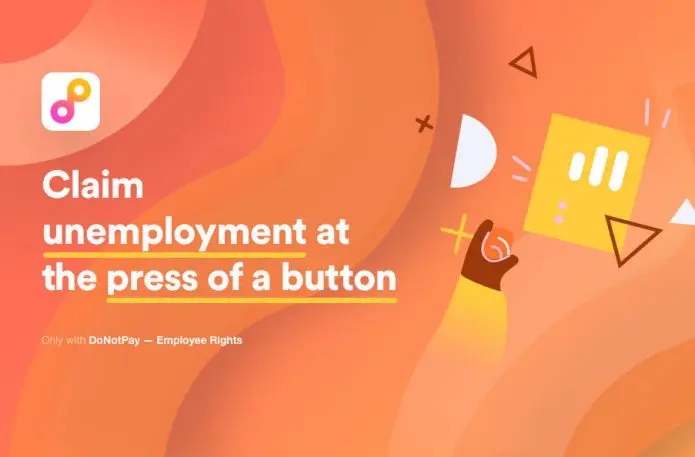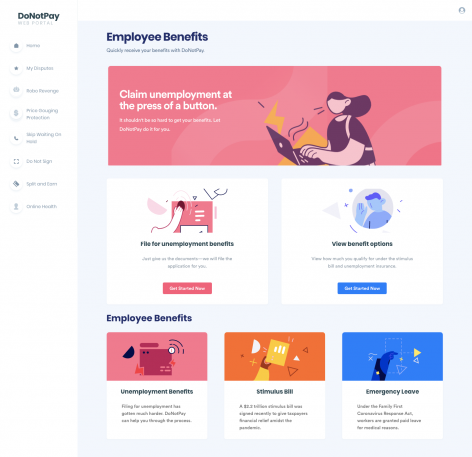As unemployment claims spike across the United States, a startup called DoNotPay is helping people fill out claim forms and get through to their states’ jammed phone lines.
Through a new section of DoNotPay’s app and website, users can set up robocalls to their state’s unemployment line, then get a call back when someone answers. They can also look up unemployment information for their state, fill out the requisite paperwork through a chatbot, and have DoNotPay submit the forms on their behalf.
An estimated 16 million people have lost their jobs in the past three weeks, many due to the COVID-19 pandemic. But with millions of unemployment claims overwhelming states’ websites and phone lines, some have been unable to access benefits. DoNotPay aims to help by creating a more user-friendly and effective way to submit an unemployment claim.
The startup already offers chat-based interfaces for other anti-bureaucracy tasks, from filing small claims lawsuits to generating customer service complaints, so its unemployment benefit tool was a natural extension. Users get a list of documents they need up front, then answer a set of questions that DoNotPay uses to fill out the necessary forms. (DoNotPay has three employees working full-time on updating the process for each state as criteria changes.)

If a phone call is necessary, DoNotPay can automatically call a state’s unemployment line roughly once per hour. Once it reaches a human representative, it will call the user back and connect them. (The robocall tool uses several prerecorded phrases to stall the representative while ringing up the user.) This is based on an existing DoNotPay feature that skips through hold times for customer service calls.
“Usually with DoNotPay, we like to focus on issues that affect millions of people, and to be honest, before this crisis, unemployment probably wasn’t one of those issues,” says Joshua Browder, DoNotPay’s CEO. “But now, 30% of the population is estimated to collect unemployment, so we see this as being a very popular product.”
‘The systems are breaking’
That 30% figure comes from James Bullard, the president of the Federal Reserve Bank of St. Louis, who delivered the bleak forecast to Bloomberg last month. While his estimate is up for debate, 6.6 million people filed for unemployment last week alone according to the U.S. Department of Labor.
State unemployment offices are struggling to keep up with jobless claims, adding frustration to an already nerve-wracking scenario for those out of work. Some states are only accepting new claims at certain hours of the day, and several states’ antiquated systems have been running into glitches.
In other cases, residents must complete their requests by phone—either because the state requires it or because an issue with their claim has come up. But their states’ calling systems can’t meet the demand. Last week, reporters for Vice tried to call unemployment offices in all 50 states, but could only get through in Arizona and Mississippi.
“The systems are breaking, and even when they’re not broken, they have opening hours, no one’s picking up the phone, all this terrible stuff,” Browder says. “It seemed like something we could do because we have the infrastructure to do it.”
Automating unemployment claims
Matthew Lee, who worked part-time as a substitute teacher in the Los Angeles area until California shut down schools in mid-March, says he’d put off filing for unemployment after trying to navigate through the state’s website. As an existing DoNotPay user, he then received an invite to use a prerelease version of the unemployment tool, which was far less confusing.
“It was night and day looking at the app, and how it was so user-friendly,” Lee says. “What I really liked was having it tell you what you needed beforehand, and that the language they used was very simple.”
Browder expects that some users won’t be comfortable entrusting the entire unemployment process to DoNotPay, so it’s allowing people to use it in bits and pieces. Users can download their auto-filled form from DoNotPay and submit it themselves, or they can submit their own claim form and just use the robocalling feature. At each step of the process, users will have to confirm that they’d like to proceed.
“Some people want to have DoNotPay handle their entire case. Other people might just want to pick and choose,” Browder says.


While some states are now looking to modernize their systems, and some tech companies such as Google are swooping in with their own solutions, any major fixes are going to take time. For now, DoNotPay might at least help folks navigate the antiquated, confusing systems we’re currently stuck with.
Recognize your brand’s excellence by applying to this year’s Brands That Matter Awards before the early-rate deadline, May 3.
